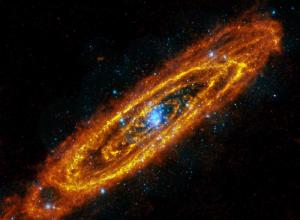Post
I’ll Fly Away
28 September 2013
 ESA/Herschel/ PACS/SPIRE/J.Fritz(U.Gent) / XMM-Newton/EPIC/W.Pietsch(MPE)
ESA/Herschel/ PACS/SPIRE/J.Fritz(U.Gent) / XMM-Newton/EPIC/W.Pietsch(MPE)A couple days ago I wrote about how one of the properties of a galaxy is that its stars are gravitationally bound. This means that the stars don’t have enough speed to escape the gravitational attraction of the galaxy, and so a star by itself can’t escape the galaxy. But this doesn’t mean that stars can never escape their galaxy. In fact, given enough time, many of them will.
This isn’t a contradiction because stars in a galaxy interact with each other gravitationally. Usually this interaction isn’t particularly strong, but if two stars have a close interaction (close in this sense being a small fraction of a light year, or a thousand times larger than the Earth-Sun distance), then the trajectories of these stars through their galaxy can change. In a typical interaction, one star will gain speed, while the other loses speed.
We actually use this effect to send probes such as Voyager 1 to the edge of our solar system, known as a gravitational slingshot. By making a close pass by Jupiter, the Voyager probes used the planet’s gravity to swing them past the planet, similar to the way a figure skater might fling another skater to give them extra speed. Of course the first skater does this at the cost of slowing themselves down. In the same way, Voyager’s gain in speed means that Jupiter loses a tiny bit of speed, but Jupiter is so much larger than Voyager that the planet’s change in speed is negligible.
Thus, a star can use a chance encounter with another star as a gravitational slingshot, and as a result gain enough speed to escape its galaxy. Over time, chance stellar encounters cause stars to escape a galaxy. This process is known as evaporation.
Of course for each star that gains enough speed to escape the galaxy, there is another star that gave up some of its speed to the escaping star. With a slower speed, the losing star will shift its orbit inward, toward galactic center. Through their gravitational encounters, some stars evaporate from the galaxy, while others are pushed closer and closer to galactic center.
For stars close to galactic center, gravitational radiation means they make a slow spiral closer and closer to the central black hole, eventually being captured by it. By some estimations1 about 10% of the mass of a galaxy will be captured by the central black hole, which the other 90% escape the galaxy forever.
While this process does happen, it happens over an extremely long time scale. The complete evaporation of a galaxy such as ours would take on the order of 1018 years, or 10 billion billion years. Long before that, stellar production in the galaxy will have stopped, and the light of the last star will have faded.
Adams, Fred C., and Gregory Laughlin. “A dying universe: the long-term fate and evolutionof astrophysical objects.” Reviews of Modern Physics 69.2 (1997): 337. ↩︎